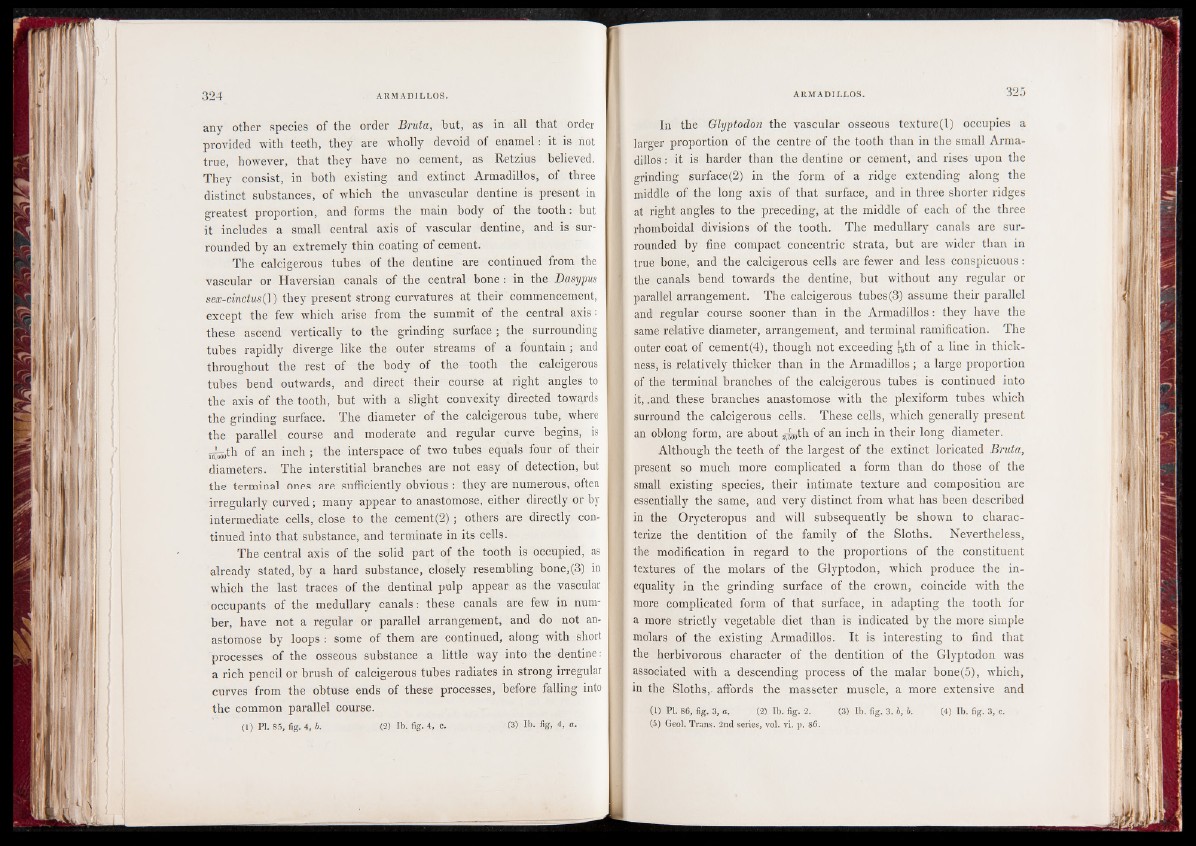
any other species of the order Bruta, hut, as in all that order
provided with teeth, they are wholly devoid of enamel: it is not
true, however, that they have no cement, as Eetzius believed.
They consist, in both existing and extinct Armadillos, of three
distinct substances, of which the unvascular dentine is present in
greatest proportion, and forms the main body of the tooth: but
it includes a small central axis of vascular dentine, and is surrounded
by an extremely thin coating of cement.
The calcigerous tubes of the dentine are continued from the
vascular or Haversian canals of the central bone : in the Dasypus
sex-cinctusQ) they present strong curvatures at their commencement,
except the few which arise from the summit of the central axis:
these ascend vertically to the grinding surface ; the surrounding
tubes rapidly diverge like the outer streams of a fountain ; and
throughout the rest of the body of the tooth the calcigerous
tubes bend outwards, and direct their course at right angles to
the axis of the tooth, but with a slight convexity directed towards
the grinding surface. The diameter of the calcigerous tube, where
the parallel course and moderate and regular curve begins, is
^„th of an inch ; the interspace of two tubes equals four of their
diameters. The interstitial branches are not easy of detection, but
the terminal ones are sufficiently obvious : they are numerous, often
irregularly curved; many appear to anastomose, either directly or by
intermediate cells, close to the cement(2); others are directly continued
into that substance, and terminate in its cells.
The central axis of the solid part of the tooth is occupied, as
already stated, by a hard substance, closely resembling bone,(3) in
which the last traces of the dentinal pulp appear as the vascular
occupants of the medullary canals: these canals are few in number,
have not a regular or parallel arrangement, and do not anastomose
by loops : some of them are continued, along with short
processes of the osseous substance a little way into the dentine:
a rich pencil or brush of calcigerous tubes radiates in strong irregular
curves from the obtuse ends of these processes, before falling into
the common parallel course.
(1) PL 85, fig. 4, b. 12) lb. fig. 4, c. (3) lb. fig, 4, a.
In the Glyptodon the vascular osseous texture(l) occupies a
larger proportion of the centre of the tooth than in the small Armadillos
: it is harder than the dentine or cement, and rises upon the
grinding surface(2) in the form of a ridge extending along the
middle of the long axis of that surface, and in three shorter ridges
at right angles to the preceding, at the middle of each of the three
rhomboidal divisions of the tooth. The medullary canals are surrounded
by fine compact concentric strata, but are wider than in
true bone, and the calcigerous cells are fewer and less conspicuous:
the canals bend towards the dentine, but without any regular or
parallel arrangement. The calcigerous tubes(3) assume their parallel
and regular course sooner than in the Armadillos: they have the
same relative diameter, arrangement, and terminal ramification. The
outer coat of cement (4), though not exceeding n,th of a line in thickness,
is relatively thicker than in the Armadillos ; a large proportion
of the terminal branches of the calcigerous tubes is continued into
it, .and these branches anastomose with the plexiform tubes which
surround the calcigerous cells. These cells, which generally present
an oblong form, are about ^ tli of an inch in their long diameter.
Although the teeth of the largest of the extinct loricated Bruta,
present so much more complicated a form than do those of the
small existing species, their intimate texture and composition are
essentially the same, and very distinct from what has been described
in the Orycteropus and will subsequently be shown to characterize
the dentition of the family of the Sloths. Nevertheless,
the modification in regard to the proportions of the constituent
textures of the molars of the Glyptodon, which produce the inequality
in the grinding surface of the crown, coincide with the
more complicated form of that surface, in adapting the tooth for
a more strictly vegetable diet than is indicated by the more simple
molars of the existing Armadillos. It is interesting to find that
the herbivorous character of the dentition of the Glyptodon was
associated with a descending process of the malar bone(5), which,
in the Sloths,, affords the masseter muscle, a more extensive and
(1) PI. 86, fig. 3, a. (2) lb. fig. 2. (3) lb. fig. 3. b, b. (4) lb. fig. 3, c.
(5) Geol. Trans. 2nd series, vol. vi. p. 86.